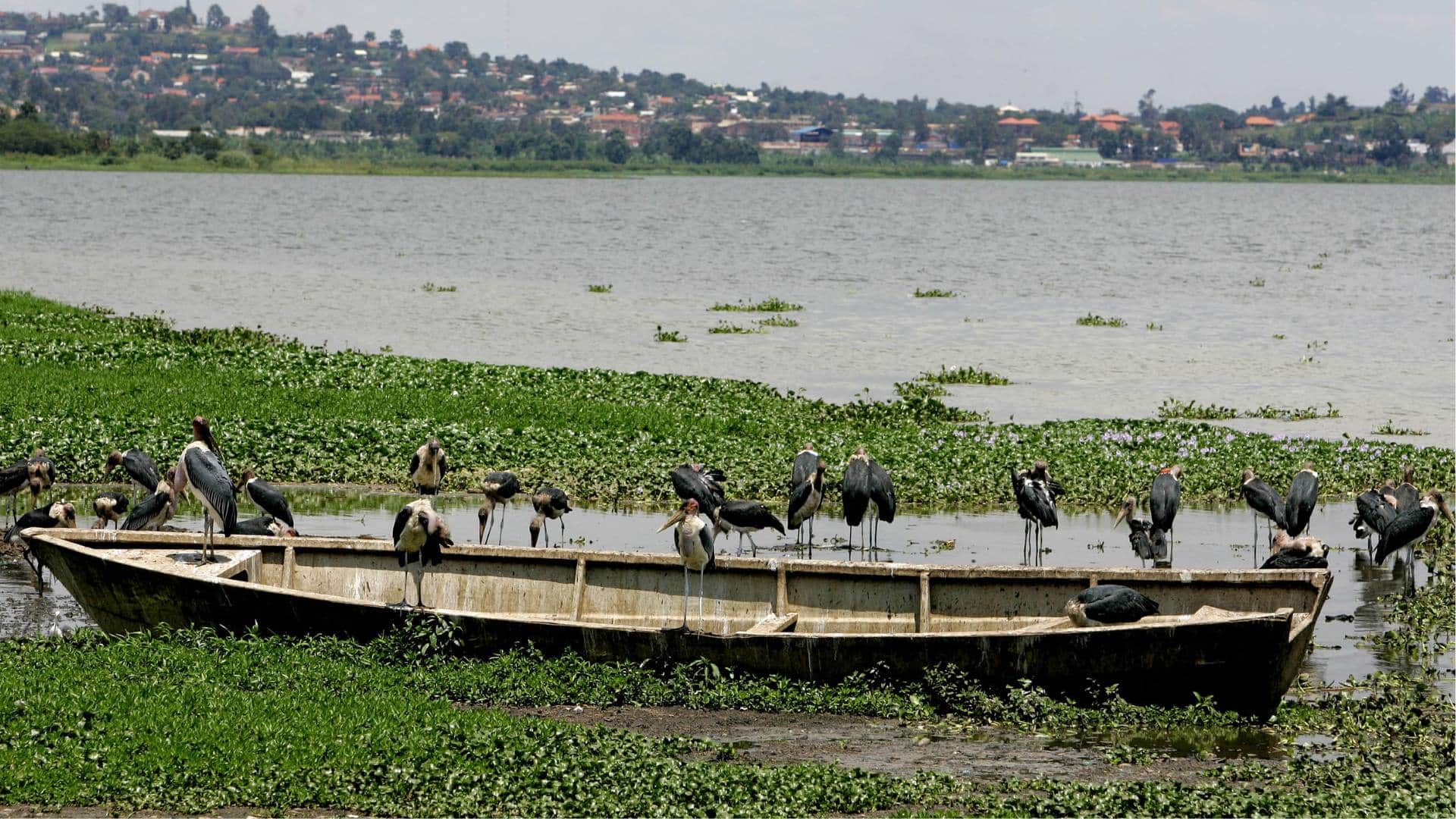Not too long ago, water hyacinth covered Lake Victoria in Africa. People found a tiny bug could help control it. Now farmers see the weed as a resource.

Marabou storks sit on a fishing boat surrounded by water hyacinths in the shallow waters in the fishing village of Ggaba, Uganda, 3 November 2006. (AP Photo/Kirsty Wigglesworth)
In a tale from colonial times, a white settler travelling through Latin America acquired a water floating plant renowned for its lavender flowers. Whether out of botanical admiration or a gesture of affection, the settler introduced this picturesque plant, the water hyacinth, to a pond in Africa.
However, the plant proved difficult to confine. Discarded into various waterways, including Rwanda’s River Kagera, it floated majestically to Uganda, and eventually found respite in Lake Victoria.
Over the next decades, the plant would cover the world’s largest tropical lake and second largest freshwater body.
“From the air, it looked beautiful — a large green mat on the lake,” said Charles Wendo, a veterinary doctor doubling as a science journalist in Uganda.
By the 1990s the water hyacinth covered 80% of the lake. The weed had paralysed a lot of things making it a waste of time to spend a day at the beach. “Everyone was concerned,” Wendo said.
Fighting an invasion
Efforts to control the weed and restore the lake seemed challenging. What turned out to be most effective wasn’t a chemical weed killer but a tiny beetle that could feed off it. Now scientists and farmers are finding that other animals could feed off the weed as well.
Godfrey Bagimbe, a transport officer, fished on Lake Victoria as a teenager.
“It used to be blown in large masses by strong winds from one shoreline to another,” Bagimbe said. “Sometimes, we would sail to areas we thought were clear, only for the wind to carry in thick mats of the weed.”
Fishing would pay for tuition for school but it would often turn out to be a waste of time. “Trapped in masses of the weed, we had to painstakingly cut through it with paddles to navigate our canoes,” Bagimbe said. “What should have taken three minutes turned into agonising hours.”
Orphaned at a young age, Bagimbe left school to pursue fishing full time but it was a struggle. “The fishing nets I had invested in couldn’t withstand the onslaught of the weed,” he said. “When it accumulates in large masses, the weed forms a cotton-like web with its roots. When our nets get ensnared in it, it spells trouble!”
“Imagine casting 30 nets, each costing about three euros, only to lose nearly 25 of them to the relentless grip of the weed,” Bagimbe said. For small-scale fishermen in Uganda, losing 25 out of 30 nets could spell the difference between heading back to the waters the next day to fish or facing the abrupt end of their livelihoods.
Understanding how nature works
Now 40 years old and a father of four, Bagimbe remains perplexed about the origins and eventual decline of the weed in Lake Victoria. “It’s intriguing how such a floating weed, with roots immersed in water — essentially in empty space — could pose such a threat,” Bagimbe said. “I still wonder: what does it even feed on? Maybe it just absorbs water.”
Bagimbe’s story was not unique. Water transport virtually ground to a halt, crippling the fishing industry and posing a significant threat to Uganda’s economy.
Wendo said that in the mid-1990s, the government stepped in. “There was intense emotional debate on how to tackle the invasive weed,” he said. “People were uncertain about the best course of action. Some proposed chemical spraying, but this met strong opposition due to fears of contaminating the water body and its ecosystem.”
Lake Victoria supports over 42 million people, serving as a vital source of food, employment and clean drinking water.
It wasn’t the first time anyone tried to combat the weed. Andrew Ndawula, an organic farmer from Uganda, said Egypt so dreaded the spread of the weed through the Nile to the Mediterranean, it began providing machinery in the mid-1990s for manual removal efforts. These engagements continue to date.
In Uganda, Wendo said, some people experimented with weevils. “These tiny creatures acted as a biological enemy to the water hyacinth,” Wendo said. “When the weevils feed on the weed, it wilts, reducing its ability to multiply. That is how Uganda likely managed to control the situation.”
Bringing balance to an ecosystem
Scientists say that the invasive weed significantly depletes oxygen levels in water bodies, posing a formidable threat to aquatic life, like the African manatee.
In the West African nation of Cameroon, water hyacinth have turned Lake Ossa, a natural habitat to a secretive African manatee population, into a hazardous pool covered in the suffocating blanket of the weed. The manatee must surface every five minutes for a gasp of air, but the dense mats of vegetation make that difficult.
A team of conservationists from the African Marine Mammal Conservation Organization employs weevils to feed off water hyacinth in Cameroon. Conservationists there report a promising development; the weevil has so far reduced the invasive weed by more than 70%.
And while it has been largely controlled in East Africa, newspapers report sporadic instances of the weed resurfacing in various parts of Lake Victoria.
So far, Bagimbe is not alarmed. “I can’t speak for other areas, but I know it’s no longer a threat around my region,” he said. “However, you won’t miss it if you look — it’s always present on the lake.”
Cycles of nature
Wendo said the weed resurfaces because biological control won’t completely eradicate it. “The weevils are parasites that feed on the weed, thereby reducing its volume,” he said. “When the weed diminishes, the weevils also decrease in number, but they reproduce and resume their role when the weed proliferates again.”
The method therefore controls water hyacinth in cycles, he said. And that means it will inevitably resurface.
Wendo said that instead of trying to eradicate the water hyacinth, see it instead as a possible resource.
“While searching for a research topic for my undergraduate degree, I stumbled upon a photograph of a pig consuming water hyacinth,” Wendo said. “It struck me that media reports focused solely on the dangers posed by the weed, prompting me to explore the potential feeding value of water hyacinth.”
He did some preliminary research, but couldn’t afford to complete it. Instead, after graduating in 1996, Wendo wrote a newspaper article on the animal feeding potential of water hyacinth. “I had never come across a story that highlighted the animal feeding value of water hyacinth before,” he said.
Wendo was unaware of the impact his story would have.
From weed to feed
Organic farmer Ndawula, an avid reader, recalls reading articles about the potential for water hyacinth as an animal feed.
Ndawula had already valued the weed for its ability to speed up decomposition of compost. He now experiments with it as an animal feed. “We observed that pigs eat it,” he said. “So, we decided to grow it in water tanks, feed it to the pigs and use their waste as manure,” he explains.
Markedly, Ndawula’s water tanks also house fish, as the hyacinth feed on the fish waste.
This confirms what Jolly Kabirizi, a professor of agriculture and a Ugandan farmer and forage scientist found. “Water hyacinth can absorb minerals and inorganic substances from sewage,” Kabirizi said. “It can grow rapidly in various conditions. After using it to clean sewage, it can be used as organic fertiliser, such as compost or mulch.”
Studies show that pollution speeds the spread of water hyacinth across the lake. So the more chemicals and trash we dump in, the more the hyacinth have to feed on, making the plant a natural cleansing agent.
Other uses for an invasive plant
Wendo highlights research conducted by Busitema University in Uganda, which explored whether water hyacinth fibre, when dried, burned and its ash collected and mixed with cement, could produce durable earth blocks for construction.
“By compressing the mixture to form strong blocks, there would be no need for burning, which contributes to deforestation,” Wendo said. “It’s also cost-effective, as water hyacinth ash fills a significant portion that would otherwise be occupied by cement.”
The research may not have yielded positive results, but it demonstrated that water hyacinth ash has potential beyond initial expectations. The World Food Programme, for example, is utilising water hyacinth in South Sudan as sustainable fuel for cooking.
But attempts to leverage the benefits of the plant come up against calls by international bodies and policymakers to eradicate it, particularly after incidents like one in 2020, where hydro power dam operators in Uganda blamed an invasion of the weed for a nationwide blackout.
Ndawula plans to expand his water hyacinth farm to a larger wetland to maximise its value. But it is a risk. The weed grows like crazy every two weeks and by transferring it to a swamp the story could flip from one of an ambitious Ugandan farmer making the most of the weed to one where he is blamed for launching a nationwide invasion.
Uganda’s neighbour, Kenya, regulates the water hyacinth as a ‘noxious weed’. But Ndawula is confident.
“It will be far from any major water body, and Uganda’s regulations are lax — I’ve never faced any issues growing it,” he said.
Three questions to consider:
- What makes the water hyacinth so dangerous?
- Why can’t the weevil completely kill off the water hyacinth?
- Can you identify an invasive plant that affects your area or country?

Enock Wanderema graduated in 2022 from Uganda’s Christian University, with a first class degree in Mass Communication and Journalism. He is a regular contributor to Uganda’s Daily Monitor newspaper and has been an intern in the Kampala office of UN Global Pulse. He loves writing and bringing complex stories to life in the simplest ways.
